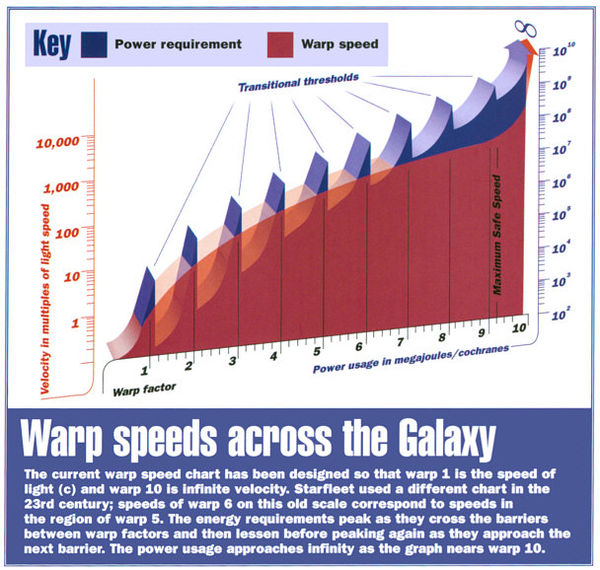Warp Theory: Difference between revisions
Aigle Phos (talk | contribs) m (→Warp theory) |
m (added blurb for warp XV drive.) |
||
| (2 intermediate revisions by one other user not shown) | |||
| Line 1: | Line 1: | ||
{{Academy-Engineering}} | {{Academy-Engineering}} | ||
Beginning in the mid-21st century, Zefram Cochrane, working with his team, laboured to derive the basic mechanism of continuum distortion propulsion (CDP). Their crusade finally led to a set of complex equations, materials formulae, and operating procedures that described the essentials of superluminal flight. In those original warp drive theories, single (or at most double) shaped fields, created at tremendous energy expenditure, could distort the space/time continuum enough to drive a starship. In 2061 Cochrane's team succeeded in producing a prototype field device of massive proportions. Described as a fluctuation superimpeller, it finally allowed an unmanned flight test ship to straddle the speed of light. | |||
The vessel was alternating between two velocity states while remaining at neither for longer than Planck time, 1.3 x 10-43 seconds. Cochrane and his team eventually relocated to the Alpha Centauri colonies, and they continued to pioneer advances in warp physics that would eventually jump the wall altogether and explore the mysterious realm of subspace that lay on the other side. | The vessel was alternating between two velocity states while remaining at neither for longer than Planck time, 1.3 x 10-43 seconds. Cochrane and his team eventually relocated to the Alpha Centauri colonies, and they continued to pioneer advances in warp physics that would eventually jump the wall altogether and explore the mysterious realm of subspace that lay on the other side. | ||
| Line 26: | Line 19: | ||
*Warp 9 = 1516 cochranes | *Warp 9 = 1516 cochranes | ||
Warp fields exceeding a given warp factor, but lacking the energy to cross over to the next higher level, are called fractional warp factors. | |||
[[Image:Warpt.jpg|center|600px]] | |||
==Warp limits== | ==Warp limits== | ||
Eugene's Limit | Originally, Eugene's Limit stated that warp stress to increased asymptotically, approaching but never reaching a value corresponding to Warp Factor 10. Under this theory, as field values approach ten, power requirements rise geometrically, while the aforementioned driver coil efficiency drops dramatically. The required force coupling and decoupling of the warp field layers rise to unattainable frequencies, exceeding not only the flight system's control capabilities, but more important the limit imposed by the Planck time. Even if it were possible to expend the theoretically infinite amount of energy required, an object at Warp 10 would be traveling infinitely fast, occupying all points in the universe simultaneously.(Transwarp). | ||
While Eugene's Limit still holds true, due to the efforts of Dr. [[Roshanara Rahman]] and [[Oddas Aria]], Starfleet was able to discover a way to increase speed to Warp Factor 15 by using deeper layers of subspace to decrease the cochrane ratio in main space. | |||
==Warp propulsion system== | ==Warp propulsion system== | ||
Latest revision as of 09:41, 16 July 2020
| Academy Library |
|---|
Beginning in the mid-21st century, Zefram Cochrane, working with his team, laboured to derive the basic mechanism of continuum distortion propulsion (CDP). Their crusade finally led to a set of complex equations, materials formulae, and operating procedures that described the essentials of superluminal flight. In those original warp drive theories, single (or at most double) shaped fields, created at tremendous energy expenditure, could distort the space/time continuum enough to drive a starship. In 2061 Cochrane's team succeeded in producing a prototype field device of massive proportions. Described as a fluctuation superimpeller, it finally allowed an unmanned flight test ship to straddle the speed of light. The vessel was alternating between two velocity states while remaining at neither for longer than Planck time, 1.3 x 10-43 seconds. Cochrane and his team eventually relocated to the Alpha Centauri colonies, and they continued to pioneer advances in warp physics that would eventually jump the wall altogether and explore the mysterious realm of subspace that lay on the other side. How does it work?The key to the creation of subsequent non-Newtonian methods, i.e., propulsion not dependent upon exhausting reaction products, lay in the concept of nesting many layers of warp field energy, each layer exerting a controlled amount of force against its next-outermost layer. The cumulative effect of the force applied drives the ship forward and is known as asymmetrical peristaltic field manipulation (APFM). Warp field coils in the engine nacelles are energized in sequential order, fore to aft. The firing frequency determines the number of field layers, a greater number of layers per unit time being required at higher warp factors. Each new field layer expands outward from the nacelles, experiences a rapid force coupling and decoupling at variable distances from the nacelles, simultaneously transferring energy and separating from the previous layer at velocities between 0.5 c and 0.9c. This is well within the bounds of traditional physics, effectively circumventing the limits of General, Special, and Transformational Relativity. During force coupling the radiated energy makes the necessary transition into subspace, applying an apparent mass reduction effect of the ship. This facilitates the slippage of the ship through the sequencing layers of warp field energy. Warp power measurementThe cochrane is the unit used to measure the field stress. Cochranes are also used to measure field distortion generated by other spatial manipulation devices, including tractor beams, deflectors, and gravity fields. Fields below warp 1 are measured in millicochranes. A subspace field of one thousand millicochranes or greater becomes the familiar warp field. Field intensity for each factor increases geometrically and is a function of the total of the individual field layer values. Note that the cochrane value for a given warp factor corresponds to the apparent velocity of a spacecraft travelling at that factor. For example a ship traveling at warp 3 is maintaining a warp field of at least 39 cochranes and is therefore traveling at 39 times c, the speed of light. Approximate values for the integer warp factors are:
Warp fields exceeding a given warp factor, but lacking the energy to cross over to the next higher level, are called fractional warp factors. Warp limitsOriginally, Eugene's Limit stated that warp stress to increased asymptotically, approaching but never reaching a value corresponding to Warp Factor 10. Under this theory, as field values approach ten, power requirements rise geometrically, while the aforementioned driver coil efficiency drops dramatically. The required force coupling and decoupling of the warp field layers rise to unattainable frequencies, exceeding not only the flight system's control capabilities, but more important the limit imposed by the Planck time. Even if it were possible to expend the theoretically infinite amount of energy required, an object at Warp 10 would be traveling infinitely fast, occupying all points in the universe simultaneously.(Transwarp). While Eugene's Limit still holds true, due to the efforts of Dr. Roshanara Rahman and Oddas Aria, Starfleet was able to discover a way to increase speed to Warp Factor 15 by using deeper layers of subspace to decrease the cochrane ratio in main space. Warp propulsion systemThe warp propulsion system consists of three major assemblies:
The system provides energy for its primary function, propulsion, as well as its secondary function, powering essential systems like shields, phaser arrays, the main deflector, and the computer core. To learn more about each of the elements that make up a standard warp propulsion systems click here. |


